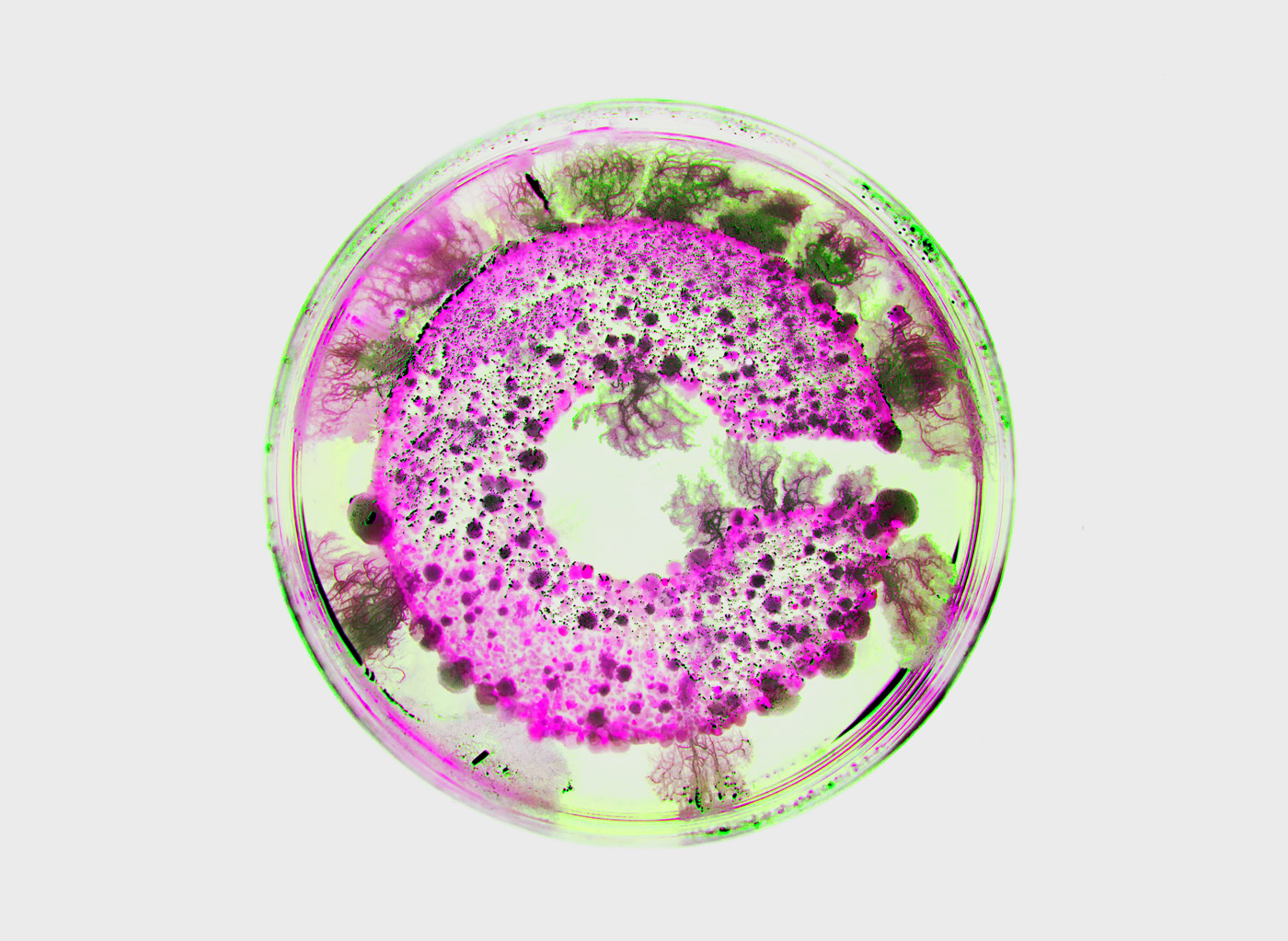BY CHRIS COLLICOTT / MADALENA STUDIO
Bacteria growing in your basement isn’t exactly the first thing that springs to mind when you think about the end product of sipping delicious drinks and cocktails, but with enough photoshop and a bit of madness / enough stupidity, it really is possible to shoehorn any idea into any brief.
When Stu asked us to revamp the Crucible website, my graphic designer eyes gleefully lit up with the idea of doing “a cheeky little rebrand.” Little did I know that those excited eyes would soon be really fucking tired eyes, blearily spending hours on end in my darkened basement taking pictures of mould.
When we created the original brand look and feel way back in 2017, Crucible’s aim was to get bartenders and brands to come and fuck about with rotovaps. Fast forward to 2024 however, and it’s quite a bit more than that.
Reflecting Crucible in 2024 needed something impactful. Our initial digital experiments with liquid effects felt fun, but inauthentic (and obviously been done to death).
Step in the big idea – let’s grow bacteria in the shape of the Crucible logo. A quick crash course on using our studio’s laser cutter, 20 quid on some petri dishes from Amazon (I know) and a lot of burnt cork later, we were mixing up soil solutions in the kitchen. My partner Kasia’s masters in microbiology being put to use for the first time in 15 years.
We set up a sterile lab environment of gas hob, Kasia’s second best tweezers and a dish of nondescript white spirit, and set about creating our first set of samples, using soil solution, saliva and some very well-aged kombucha. We applied the sample to the cork ‘C’s and pressed into the petri dishes. Five samples to start.
There are artists out there growing bacteria in similar-ish ways, and some graphic designers too, but we had no idea if this would actually work or what the outcome could even look like.
The next sterile-conditions space was a plastic box, perched above an old radiator by two chairs in my blacked out (and unventilated) basement – perfect studio conditions if not a bit risky from a health point of view. I left the samples in the box and within just 24hrs, some of the samples were in full bloom. If anything, I’d actually left it too long and missed the initial growth, however I set up the camera and started documenting.
In hindsight, a bit of a clearout in the basement would have made the BTS video a bit nicer, but hey, stop judging. Maybe even the kitchen if I’m being really honest.
So, we had some bacteria, in the shape of a C, but the natural muted colour wasn’t really doing it. Whilst authenticity was key, this was a design project, so whilst we never manipulated any of the bacteria or images, the beige could get fucked. Like every pretentious drink that you wished just tasted good, we wanted to create visual pleasure.
We pushed, pulled and inverted the colours to bring the bacteria into a more palatable form, resulting in one image that really worked. The best initial sample grew from the soil solution, resulting in colonies of stuff like genus Streptomyces, Micrococcaceae, and Bacillus, with what we think is most likely mycelial networks literally branching out and exploring the limits of the dishes. I’ve always loved pattern and natural textures, and to see this really quite beautiful growth appearing and be able to show it off in a piece like this was really great.
There’s a lot of precision and accuracy and control over detail in the creative world, but there’s a purity and beauty in letting something natural and unexpected take it’s course that really cannot be designed, coded or even AI’d.
Where things really took a turn for the really ridiculous was me suggesting we create a timelapse video with a new set of samples. Unfortunately, to get a smoothly transitioning short clip required at least 60-80 stills, (with the rapid growth we were experiencing) shot over 3-4 days, required shots to be taken every 3 or so hours. All day, all night. Last photo set at midnight followed by alarms at 3am and 6am to put a mask on to go and grouchily sit in the basement for 20 mins positioning samples under the camera taking photos is not something I’d recommend. I’m currently used to sleep deprivation thanks to thin walls and my otherwise delightful neighbour’s 1 year old, but I was mainly pleased that I didn’t get some horrible illness from growing all this weird shit.
Continues below
To try and cultivate a wider variety of bacteria, we used more and a wider set of samples, including Stu’s home grown liquid culture of lions mane fungi, mould, swabs from food waste, skin and one that worked horrifyingly well; swabs from my phone.
Each grew into hugely differing worlds – some appeared like forests, some looked like flowers, some like scenes from a science fiction film. One bit looks a lot like a wonton. Arguably with more time / budget / skills / equipment we could have captured it better (David Attenborough and your production team, DM me for collab), but we’d gone far enough down the wormhole already.
The video production stage was just as time consuming – we had over 1500 individual RAW frames to process (shout out to my ace designer Oliwia Mendel), keeping the quality as high as possible up to the video rendering stage. We explored various treatments, but kept coming back to the original image style, aiming to get the balance between seeing the bacteria and it not being too gross for the drinks vibe. I think my favourite is the first one on the website, where colonies are literally moving around the dish, only visible when the video was finally rendered.
The website edit is a selection of five out of about 30 samples, with a longer edit of 15ish above. Some worked better than others. But it was a fun process if not a bit mad. I had thought I never wanted to do a project like this again, but I’m moving house soon and the new place has a garage so yeah, let’s see.

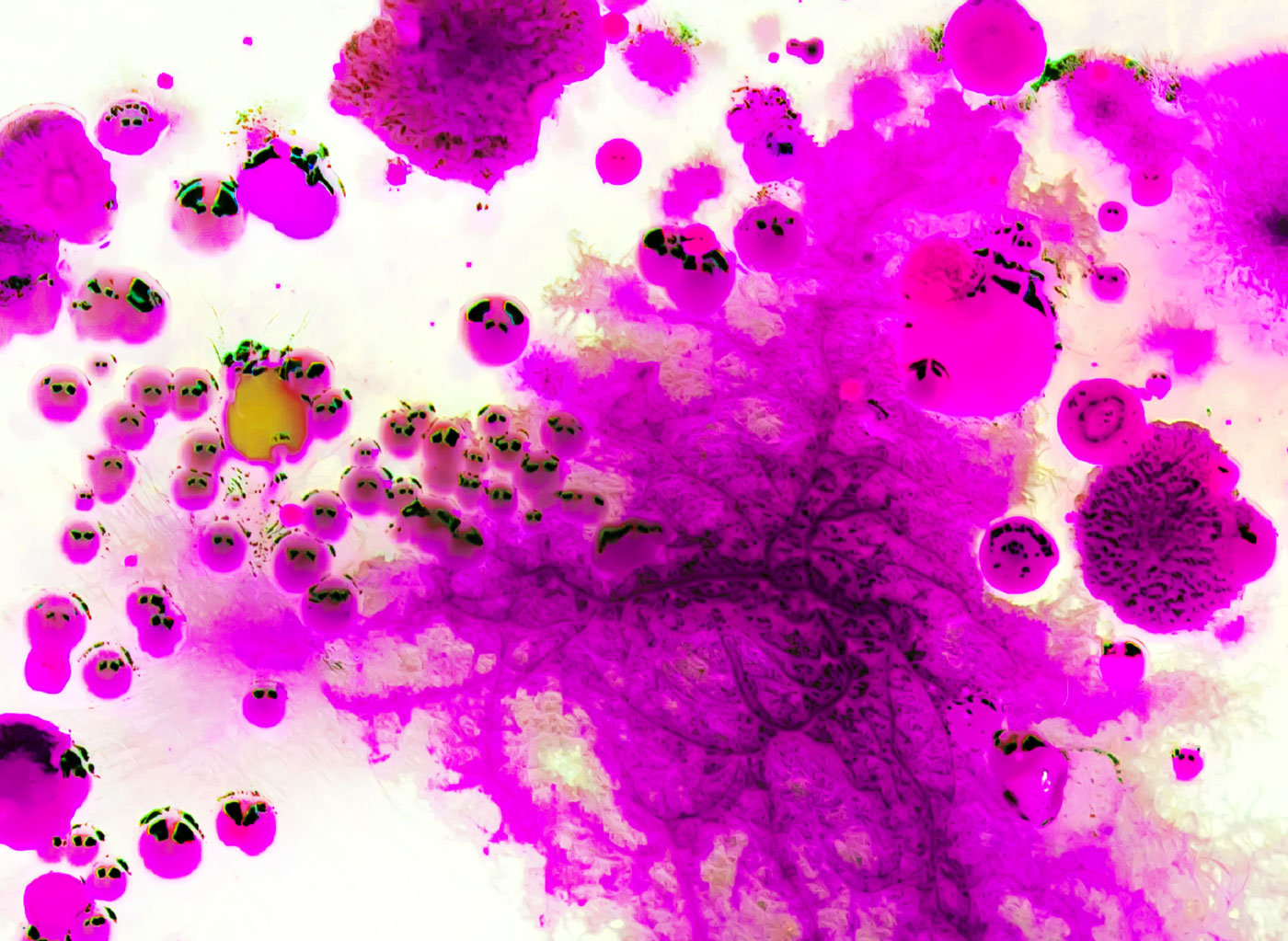
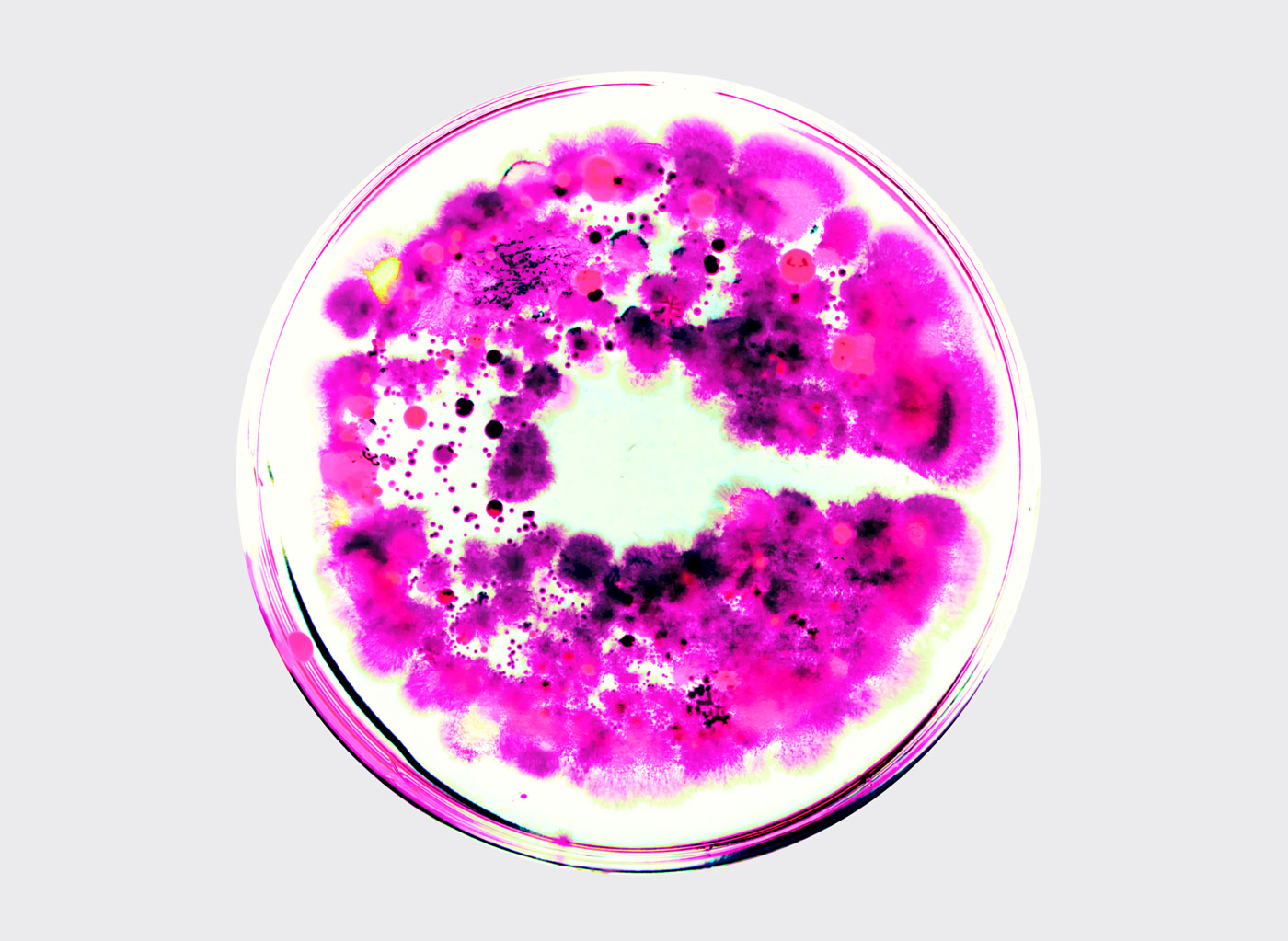

Basement
Bacteria
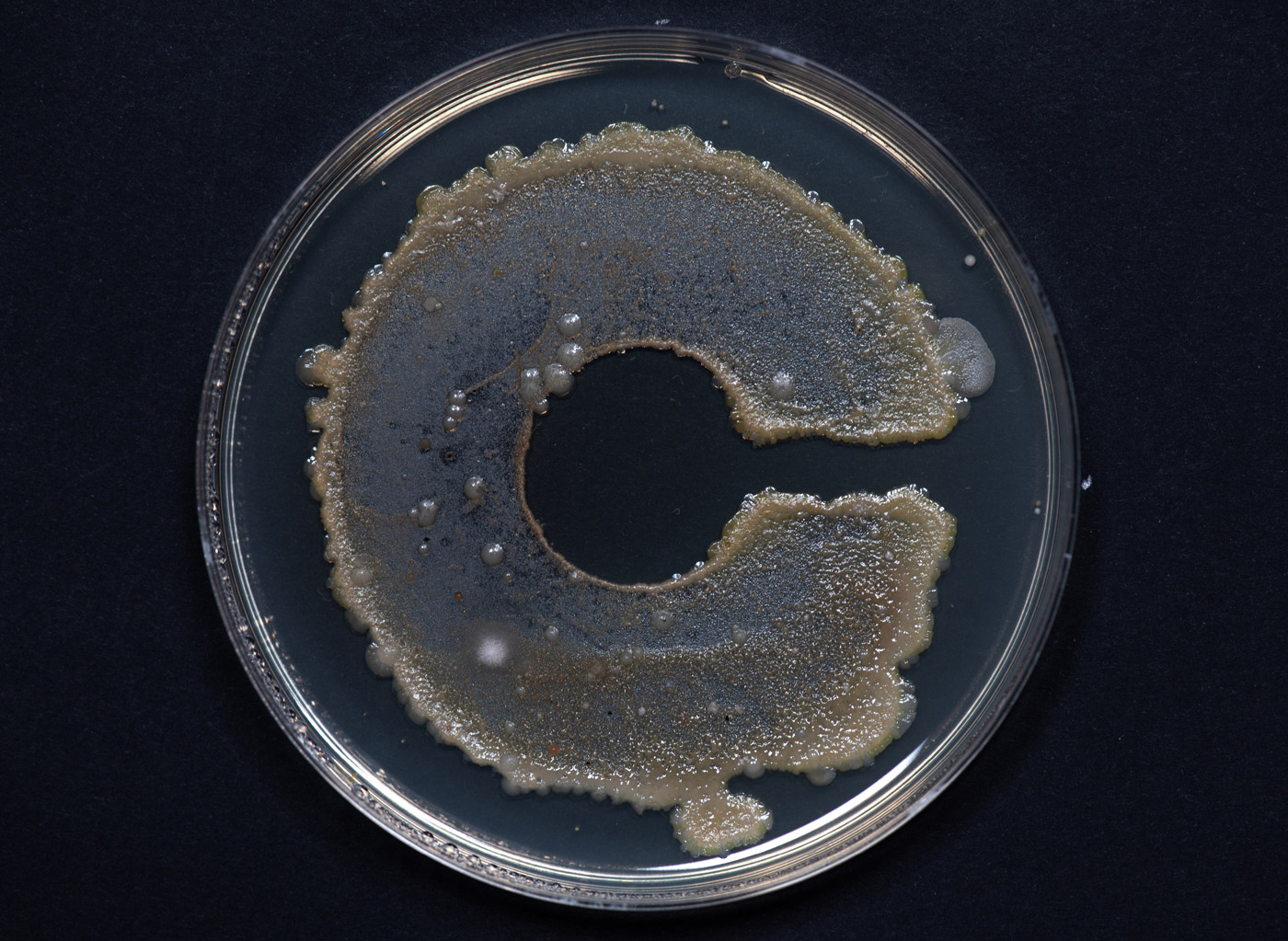
Bacteria growing in your basement isn’t exactly the first thing that springs to mind when you think about the end product of sipping delicious drinks and cocktails, but with enough photoshop and a bit of madness / enough stupidity, it really is possible to shoehorn any idea into any brief.
When Stu asked us to revamp the Crucible website, my graphic designer eyes gleefully lit up with the idea of doing “a cheeky little rebrand.” Little did I know that those excited eyes would soon be really fucking tired eyes, blearily spending hours on end in my darkened basement taking pictures of mould.
When we created the original brand look and feel way back in 2017, Crucible’s aim was to get bartenders and brands to come and fuck about with rotovaps. Fast forward to 2024 however, and it’s quite a bit more than that.
Reflecting Crucible in 2024 needed something impactful. Our initial digital experiments with liquid effects felt fun, but inauthentic (and obviously been done to death).
Step in the big idea – let’s grow bacteria in the shape of the Crucible logo. A quick crash course on using our studio’s laser cutter, 20 quid on some petri dishes from Amazon (I know) and a lot of burnt cork later, we were mixing up soil solutions in the kitchen. My partner Kasia’s masters in microbiology being put to use for the first time in 15 years.
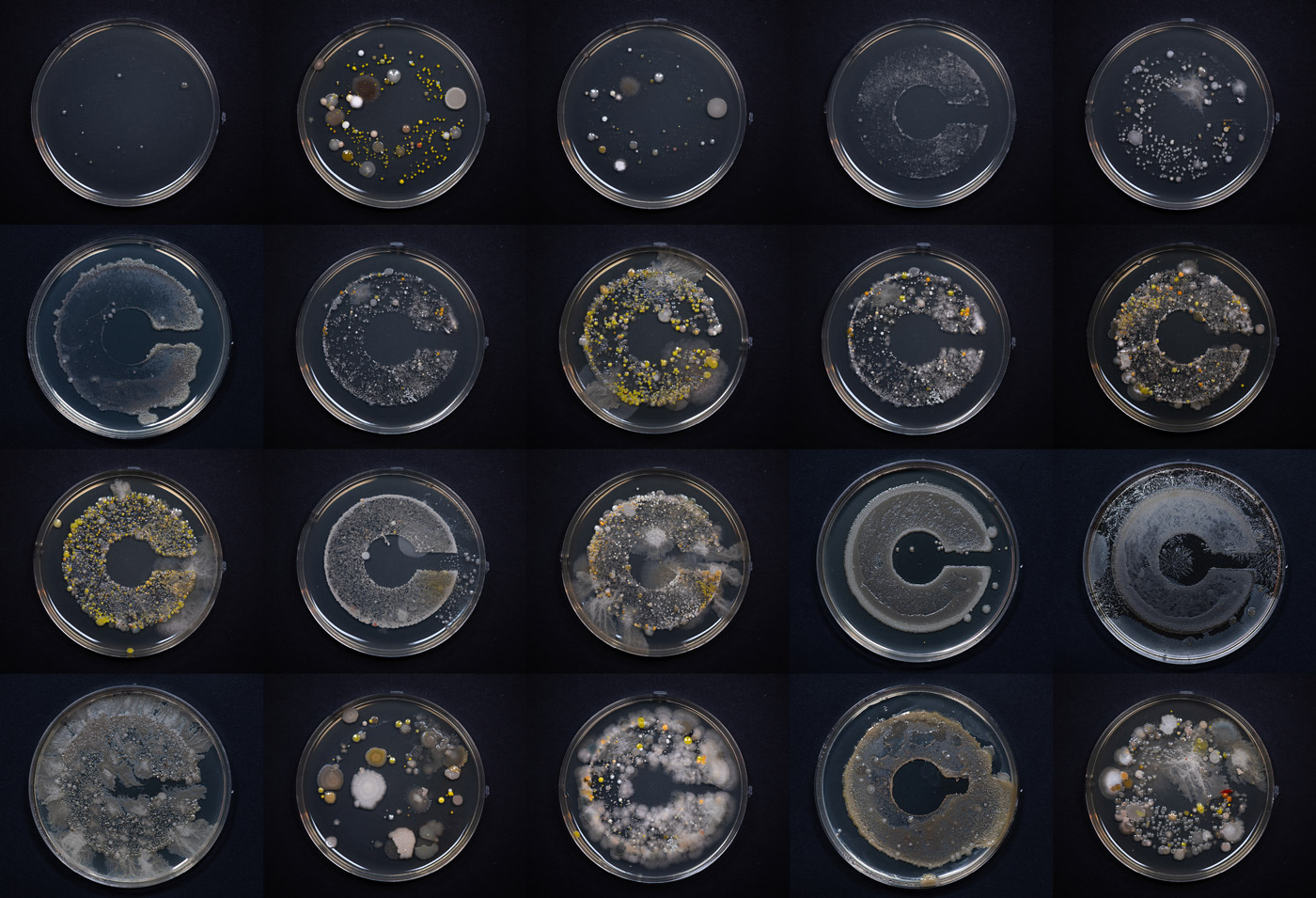
Bacterial growth at various stages
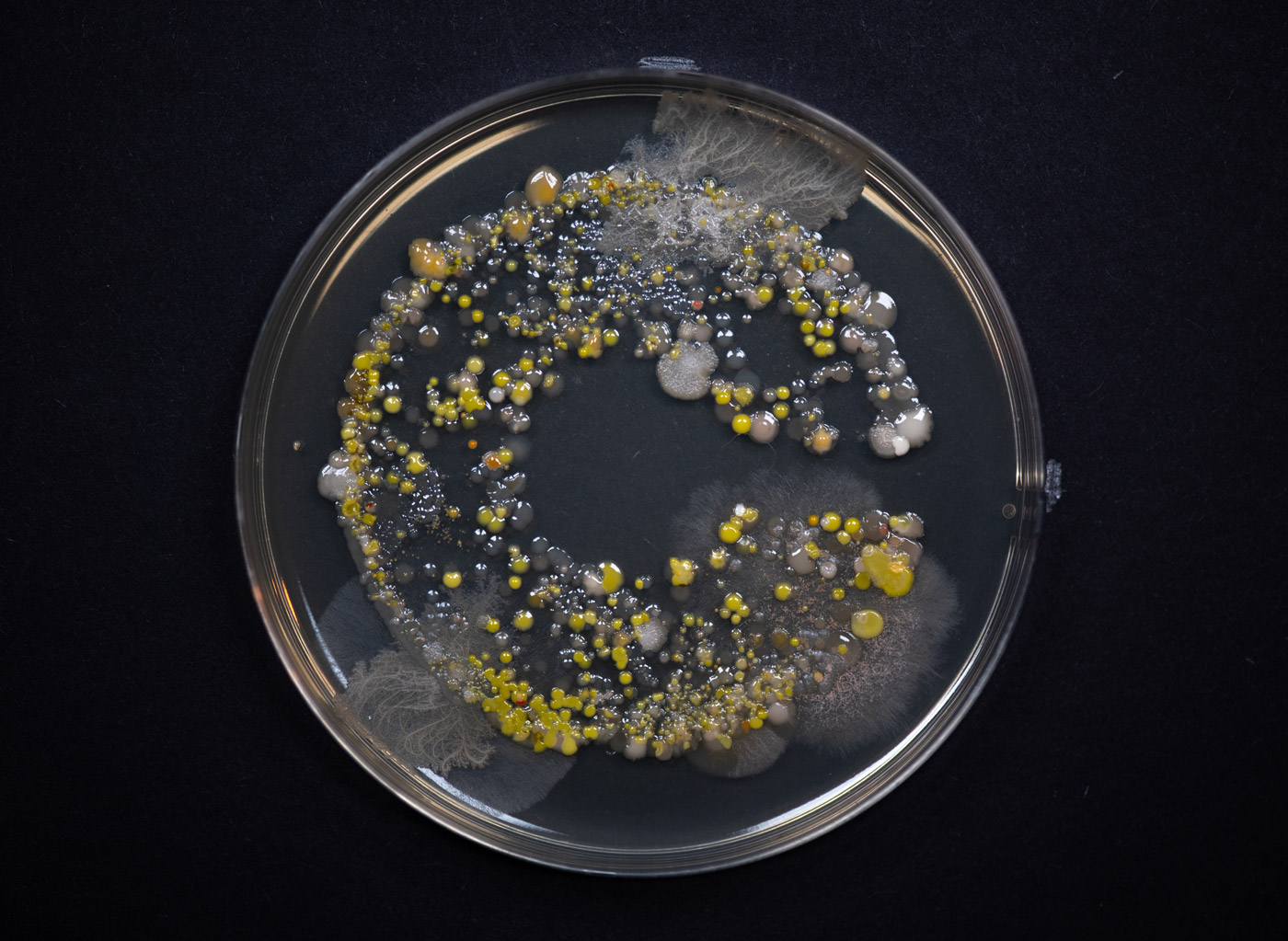
Food waste sample
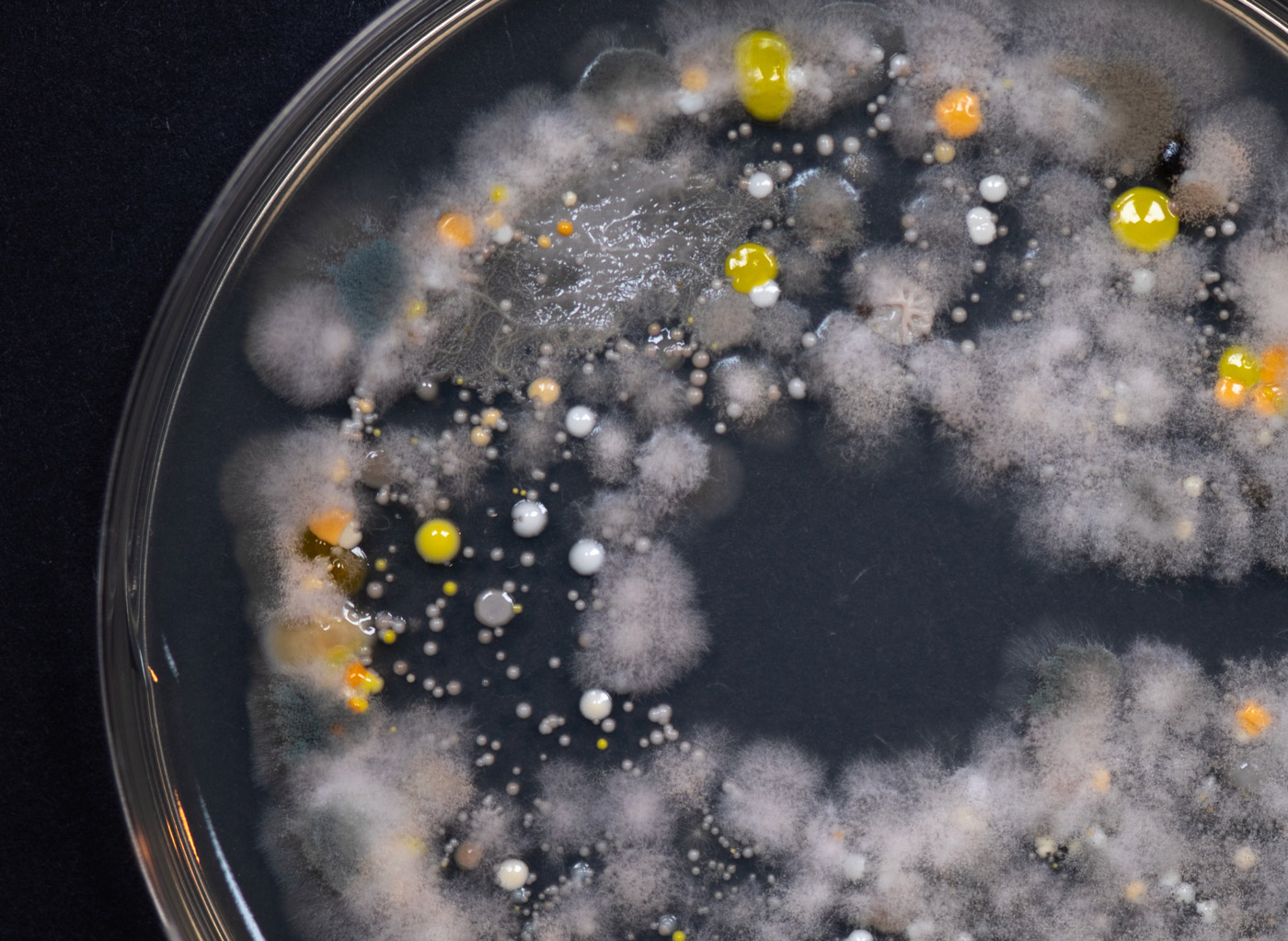
Skin swab sample

Liquid culture of lion’s mane sample
We set up a sterile lab environment of gas hob, Kasia’s second best tweezers and a dish of nondescript white spirit, and set about creating our first set of samples, using soil solution, saliva and some very well-aged kombucha. We applied the sample to the cork ‘C’s and pressed into the petri dishes. Five samples to start.
There are artists out there growing bacteria in similar-ish ways, and some graphic designers too, but we had no idea if this would actually work or what the outcome could even look like.
The next sterile-conditions space was a plastic box, perched above an old radiator by two chairs in my blacked out (and unventilated) basement – perfect studio conditions if not a bit risky from a health point of view. I left the samples in the box and within just 24hrs, some of the samples were in full bloom. If anything, I’d actually left it too long and missed the initial growth, however I set up the camera and started documenting.

Phone swab sample

Soil solution sample
The process
In hindsight, a bit of a clearout in the basement would have made the BTS video a bit nicer, but hey, stop judging. Maybe even the kitchen if I’m being really honest.
So, we had some bacteria, in the shape of a C, but the natural muted colour wasn’t really doing it. Whilst authenticity was key, this was a design project, so whilst we never manipulated any of the bacteria or images, the beige could get fucked. Like every pretentious drink that you wished just tasted good, we wanted to create visual pleasure.
We pushed, pulled and inverted the colours to bring the bacteria into a more palatable form, resulting in one image that really worked. The best initial sample grew from the soil solution, resulting in colonies of stuff like genus Streptomyces, Micrococcaceae, and Bacillus, with what we think is most likely mycelial networks literally branching out and exploring the limits of the dishes. I’ve always loved pattern and natural textures, and to see this really quite beautiful growth appearing and be able to show it off in a piece like this was really great.

Soil solution / Initial colour treatment

There’s a lot of precision and accuracy and control over detail in the creative world, but there’s a purity and beauty in letting something natural and unexpected take it’s course that really cannot be designed, coded or even AI’d.
Where things really took a turn for the really ridiculous was me suggesting we create a timelapse video with a new set of samples. Unfortunately, to get a smoothly transitioning short clip required at least 60-80 stills, (with the rapid growth we were experiencing) shot over 3-4 days, required shots to be taken every 3 or so hours. All day, all night. Last photo set at midnight followed by alarms at 3am and 6am to put a mask on to go and grouchily sit in the basement for 20 mins positioning samples under the camera taking photos is not something I’d recommend. I’m currently used to sleep deprivation thanks to thin walls and my otherwise delightful neighbour’s 1 year old, but I was mainly pleased that I didn’t get some horrible illness from growing all this weird shit.
The long edit
To try and cultivate a wider variety of bacteria, we used more and a wider set of samples, including Stu’s home grown liquid culture of lions mane fungi, mould, swabs from food waste, skin and one that worked horrifyingly well; swabs from my phone.
Each grew into hugely differing worlds – some appeared like forests, some looked like flowers, some like scenes from a science fiction film. One bit looks a lot like a wonton. Arguably with more time / budget / skills / equipment we could have captured it better (David Attenborough and your production team, DM me for collab), but we’d gone far enough down the wormhole already.




The video production stage was just as time consuming – we had over 1500 individual RAW frames to process (shout out to my ace designer Oliwia Mendel), keeping the quality as high as possible up to the video rendering stage. We explored various treatments, but kept coming back to the original image style, aiming to get the balance between seeing the bacteria and it not being too gross for the drinks vibe. I think my favourite is the first one on the website, where colonies are literally moving around the dish, only visible when the video was finally rendered.
The website edit is a selection of five out of about 30 samples, with a longer edit of 15ish above. Some worked better than others. But it was a fun process if not a bit mad. I had thought I never wanted to do a project like this again, but I’m moving house soon and the new place has a garage so yeah, let’s see.

